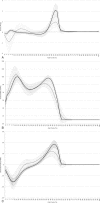Medial gastrocnemius structure and gait kinetics in spastic cerebral palsy and typically developing children: A cross-sectional study
- PMID: 29794756
- PMCID: PMC6392514
- DOI: 10.1097/MD.0000000000010776
Medial gastrocnemius structure and gait kinetics in spastic cerebral palsy and typically developing children: A cross-sectional study
Abstract
To compare medial gastrocnemius muscle-tendon structure, gait propulsive forces, and ankle joint gait kinetics between typically developing children and those with spastic cerebral palsy, and to describe significant associations between structure and function in children with spastic cerebral palsy.A sample of typically developing children (n = 9 /16 limbs) and a sample of children with spastic cerebral palsy (n = 29 /43 limbs) were recruited. Ultrasound and 3-dimensional motion capture were used to assess muscle-tendon structure, and propulsive forces and ankle joint kinetics during gait, respectively.Children with spastic cerebral palsy had shorter fascicles and muscles, and longer Achilles tendons than typically developing children. Furthermore, total negative power and peak negative power at the ankle were greater, while total positive power, peak positive power, net power, total vertical ground reaction force, and peak vertical and anterior ground reaction forces were smaller compared to typically developing children. Correlation analyses revealed that smaller resting ankle joint angles and greater maximum dorsiflexion in children with spastic cerebral palsy accounted for a significant decrease in peak negative power. Furthermore, short fascicles, small fascicle to belly ratios, and large tendon to fascicle ratios accounted for a decrease in propulsive force generation.Alterations observed in the medial gastrocnemius muscle-tendon structure of children with spastic cerebral palsy may impair propulsive mechanisms during gait. Therefore, conventional treatments should be revised on the basis of muscle-tendon adaptations.
Figures


Similar articles
-
Prolonged stretching of the ankle plantarflexors elicits muscle-tendon adaptations relevant to ankle gait kinetics in children with spastic cerebral palsy.Med Hypotheses. 2017 Nov;109:65-69. doi: 10.1016/j.mehy.2017.09.025. Epub 2017 Sep 28. Med Hypotheses. 2017. PMID: 29150297
-
Achilles tendon length and medial gastrocnemius architecture in children with cerebral palsy and equinus gait.J Pediatr Orthop. 2010 Jul-Aug;30(5):479-84. doi: 10.1097/BPO.0b013e3181e00c80. J Pediatr Orthop. 2010. PMID: 20574267
-
Mechanical muscle and tendon properties of the plantar flexors are altered even in highly functional children with spastic cerebral palsy.Clin Biomech (Bristol). 2017 Dec;50:139-144. doi: 10.1016/j.clinbiomech.2017.10.019. Epub 2017 Oct 28. Clin Biomech (Bristol). 2017. PMID: 29100187
-
[Bilateral spastic cerebral palsy with ambulatory ability (diplegia): pathophysiology, state of the art of conservative and surgical treatment and rehabilitation].Orthopade. 2014 Jul;43(7):656-60, 662-4. doi: 10.1007/s00132-013-2220-z. Orthopade. 2014. PMID: 25028280 Review. German.
-
Muscle-tendon unit in children with cerebral palsy.Dev Med Child Neurol. 2021 Aug;63(8):908-913. doi: 10.1111/dmcn.14807. Epub 2021 Jan 10. Dev Med Child Neurol. 2021. PMID: 33426691 Review.
Cited by
-
Architecture of the Triceps Surae Muscles Complex in Patients with Spastic Hemiplegia: Implication for the Limited Utility of the Silfverskiöld Test.J Clin Med. 2019 Dec 1;8(12):2096. doi: 10.3390/jcm8122096. J Clin Med. 2019. PMID: 31805732 Free PMC article.
-
Atypical triceps surae force and work patterns underlying gait in children with cerebral palsy.J Orthop Res. 2022 Dec;40(12):2763-2770. doi: 10.1002/jor.25307. Epub 2022 Mar 19. J Orthop Res. 2022. PMID: 35212418 Free PMC article.
-
Impact of Altered Gastrocnemius Morphometrics and Fascicle Behavior on Walking Patterns in Children With Spastic Cerebral Palsy.Front Physiol. 2020 Oct 7;11:518134. doi: 10.3389/fphys.2020.518134. eCollection 2020. Front Physiol. 2020. PMID: 33178029 Free PMC article.
References
-
- Rosenbaum P, Paneth N, Leviton A, et al. A report: the definition and classification of cerebral palsy April 2006. Dev Med Child Neurol 2007;49(s109):8–14. - PubMed
-
- Barber L, Carty C, Modenese L, et al. Medial gastrocnemius and soleus muscle-tendon unit, fascicle, and tendon interaction during walking in children with cerebral palsy. Dev Med Child Neurol 2017;59:843–51. - PubMed
-
- Kalsi G, Fry NR, Shortland AP. Gastrocnemius muscle-tendon interaction during walking in typically-developing adults and children, and in children with spastic cerebral palsy. J Biomech 2016;49:3194–9. - PubMed
-
- Williams SE, Gibbs S, Meadows CB, et al. Classification of the reduced vertical component of the ground reaction force in late stance in cerebral palsy gait. Gait Posture 2017;34:370–3. - PubMed
Publication types
MeSH terms
LinkOut - more resources
Full Text Sources
Other Literature Sources
Medical

